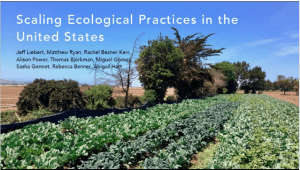Why don’t farmers adopt more ecological practices?
Produce growers are increasingly expected to not only provide safe, healthy, and affordable food to consumers, but to do so in ways that reduce or reverse the deleterious effects of intensive, industrial agricultural practices on the environment. Many on-farm practices that have a positive impact on the environment, such as cover cropping, diverse crop rotations, and non-crop vegetation management, have also been shown to benefit farm productivity. However, relatively few farmers have adopted or consistently used these management practices in the United States despite the financial support available for some of these practices through incentive programs. Consequently, there is a need to rethink the ways in which we are attempting to increase the adoption of agroecological practices.
Our project
Our overall project goal was to untangle and more fully understand the complex decision-making that leads to, or does not lead to, adoption and continued use of diversified, agroecological farming practices.
The information growers provided through in-depth interviews and a national survey allowed us to identify the factors that drive or hinder adoption of these practices at multiple scales and across a range of operation types. This information feeds the development of programs and incentives that reflect the needs of growers. The Nature Conservancy participated in this research as it helped the organization identify ways to further support and work with growers who are motivated to implement practices that are environmentally beneficial.
Objective 1. Explored how the interrelated factors that inform farmer perceptions of, and experiences with, ecological practices influence on-farm management and decision-making among small- to large-scale, organic and non-organic vegetable growers in California and New York. We contextualized this work within a broader agroecological framework with particular attention given to linkages among the underrepresented cultural, sociopolitical, and socioeconomic dimensions of agroecology. To complete this objective, semi-structured in-depth interviews were conducted.
Objective 2. Characterized the relationships and patterns of use and adoption, discontinuance, and barriers to adoption for ecological management practices among fruit and vegetable farmers in key agriculture and conservation regions in the United States. This objective was completed through the analysis of a national survey of fruit and vegetable growers.
Findings
Using data from our national farmer survey, we found that as farm size increases, the probability that an organic or conventional grower uses compost or manure, intercropping, or insectary plantings decreased. Conversely, the probability that a farmer uses reduced tillage or diverse crop rotations increases as farm size increases. When we analyzed the data by cropping system, we found that field crop or grain producers were more likely to use intercropping, for example, as farm size increases, whereas specialty crop (fruit and vegetable) growers were less likely to do so on larger farms. We also found that across all cropping systems and sizes, there was a greater proportion of organic farmers, compared with conventional growers, using six of the eight agroecological practices we assessed. The survey also indicated that improving soil health is the most important motivation for using a majority of the practices, and farm size was a top-five barrier selected for all eight practices. The differences we observed among farm size, management type, and cropping system have important implications for the scalability of agroecology in the United State.
|
|
|





